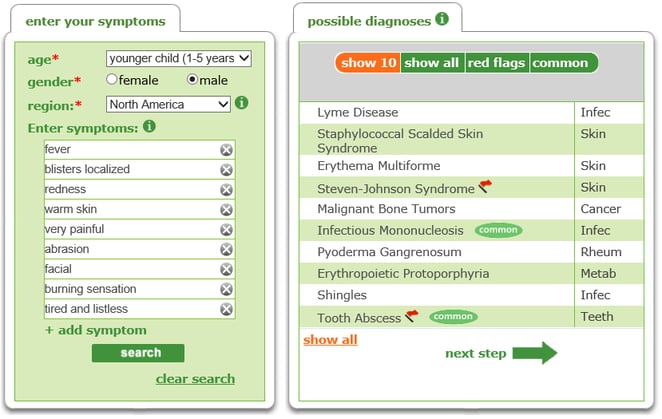- Privacy Policy
- Terms & Conditions
- Contact us
- ©Isabel Healthcare 2025
Being an Informed Patient and Parent | Isabel Symptom Checker
 Isabel visits several conferences and gatherings throughout the year in the field of health and diagnosis error. We interact with people at the forefront of misdiagnosis research and action, as well as those who are simply interested in how a diagnosis tool could help or has helped them. During one of these discussions, after hearing about the origins of Isabel Healthcare and Isabel Maude’s story of misdiagnosis, an attendee shared this recent case they had experienced with their 4 year old son.
Isabel visits several conferences and gatherings throughout the year in the field of health and diagnosis error. We interact with people at the forefront of misdiagnosis research and action, as well as those who are simply interested in how a diagnosis tool could help or has helped them. During one of these discussions, after hearing about the origins of Isabel Healthcare and Isabel Maude’s story of misdiagnosis, an attendee shared this recent case they had experienced with their 4 year old son.
A Painful Rash
The attendee explained that his son developed a rash localized to his ankle, which was very painful to touch and looked similar to hives. The rash originated via a minor abrasion to his ankle. As the area was very painful he was reviewed by a Pediatrician who noted a fever and marked the area of the rash to monitor if it increased in size over time. The rash was red in appearance and warm to touch. After returning home the rash continued to enlarge and began forming blistering eruptions. The doctor was contacted and the family were reassured that it was of no concern.
The child started to become tired and listless and the blisters began appearing on his face. The parents were now increasingly concerned; they knew something was not quite right. They turned to researching the symptoms using Google images. Comparing images of various rashes on Google with their son’s blistering rash, they felt it looked very similar to Staphylococcal Scalded Skin Syndrome (SSSS). The parents called the Pediatrician, relayed their feelings to him and said they were returning with the child to have a consultation. After seeing the young boy, the Pediatrician confirmed the diagnosis as SSSS.
Rare But Common
This scenario, where a rare condition such as Staphylococcal Scalded Skin Syndrome is misdiagnosed, is in fact a relatively common occurence. The parents are concerned their child is becoming increasingly unwell, they turn to the internet to help them research the symptoms, and find one or more potential diagnoses themselves. The parents then present their findings to their Pediatrician, who more often than not confirms the diagnosis as one which the parents had suspected. There are certainly some lessons to learn in this sequence of events:
The physician and their differential diagnosis
There are a number of factors as to why the physician fails to find the correct diagnosis at first, but a lot of the time it is because other, more common conditions also fit the symptoms. Rare diseases are not on the doctor’s mind as readily as the hundreds of diseases they see day in day out, and because of this, they can be left of a differential diagnosis. A thorough differential and considering or being reminded of all possibilities is the only way around this problem.
The parents and their instincts
We trust doctors, and have done so for centuries. They do incredible work and cure many conditions with their extensive knowledge of diseases and illnesses. However, a doctor is not all-knowing. They are human. And they do not know your child like you do. Nobody knows someone’s symptoms like the patient themselves or the parents of the patient, and this can be seriously underestimated. So, trust your instincts and ask questions of your doctor - there should be a discussion to arrive at the correct diagnosis efficiently.
The technology and research
The parents in our SSSS story went straight to Google images as a resource, and found an answer quickly. If this had been done by both patient and doctor earlier on, during the first consultation, the correct diagnosis may have been reached sooner. The physician cannot and should not be replaced by a computer - we still needed the doctor to confirm diagnosis and have the knowledge for treatment and care - but a combination of artificial technology, doctors and patients would be a dream team for improved diagnosis.Empowered Patients and the Isabel Symptom Checker
When the symptoms of the young boy’s initial presentation were run through the Isabel Symptom Checker, Staphylococcal Scalded Skin Syndrome was on the list as an important disease to consider. In this case, timely diagnosis was key as without treatment and with the child presenting with a fever and tiredness, the condition could have escalated to sepsis and shock.

Child’s presentation of symptoms – Staphylococcal Scalded Skin Syndrome appears prominently.
It is clear that being informed, and using a persistent approach where gut feelings show something is wrong, are the best ways for improving diagnosis from the patients’ and parent’s point of view. The Society to Improve Diagnosis Error in Medicine (SIDM) is a society with a mission to lead the way in improving diagnosis and eliminating harm, in partnership with patients, their families, the healthcare community, and every interested stakeholder.
SIDM publishes useful tools for Doctors and patients to utilize in order to arrive at a timely and correct diagnosis. This checklist for patients will enable them to have a fruitful discussion with their Doctor and ensure they have covered all areas and have a clear path once they arrive at a diagnosis.
Key take away points demonstrated by the SIDM’s checklist and the story above are:
- Learn about your illness by looking at reliable sources on the Internet or visit a local library
- Be informed and involved in decisions about your health
- Ask what you need to do if you get new symptoms, or start to feel worse,
- Make Sure It Is the Right Diagnosis
- Sometimes your diagnosis is the most “likely” thing that is wrong, but it may not be the “right” thing
- Encourage your doctor or nurse to think about other possible reasons for your illness.
By adhering to this checklist and using symptom checkers like Isabel to help with researching your symptoms, you are in a better position to have a fruitful discussion with your Doctor and will be an informed patient. You will hopefully reach a diagnosis or find the cause of your symptoms promptly so they can be treated and minimize any discomfort and prevent more serious complications from arising.
If you have doubts about your own or your child's diagnosis, run the symptoms through the Isabel Symptom Checker to discuss the findings with your doctor. The system is based on a professional differential diagnosis tool for doctors, and could help you reach a correct diagnosis sooner.
Image Attribution:
"Take my hand" (CC BY 2.0) by stephanski

Mandy Tomlinson
Mandy has worked for Isabel Healthcare since 2000. Prior to this, she was a Senior Staff Nurse on the Pediatric Infectious disease ward and high dependency unit at one of London's top hospitals, St Mary’s in Paddington which is part of Imperial College Healthcare NHS Trust. Her experience in the healthcare industry for the past 33 years in both the UK and USA means she's a vital resource for our organization. Mandy currently lives and works in Scottsdale, Arizona.
Subscribe Here!
Recent Posts
Isabel DDx Companion with ChatGPT Integration - to help you diagnose even faster
At Isabel Healthcare, we’ve always been driven by one goal: to make clinical reasoning faster,..Virtual Triage: Do more questions lead to better patient outcomes?
One of the common misconceptions related to virtual triage / symptom checker tools is that the more..List Of Categories
- Differential Diagnosis Decision Support
- Differential diagnosis
- Symptom Checker
- Symptoms
- Medical Error
- Patient Disease Information
- Disease
- Clinical Decision Support
- Diagnostic Decision Support
- Isabel 1 Minute Read
- Diagnosis Error
- Diagnosis Skills Cases
- Healthcare Informatics
- Clinical Reasoning
- Evidence-based Medicine
- Medical Education
- Patient Engagement
- Symptom Triage
- Nurse Practitioner Education
- Nursing Decision Support
- Partnership
- Public Health
- COVID-19
- EHR
- Patient Empowerment
- Patient Safety
- rare disease

Start your FREE Trial today
Try the Isabel Pro DDx generator for 30-days - no payment card details required.




